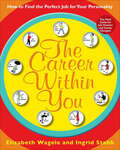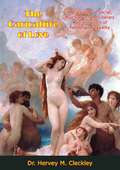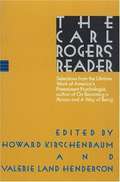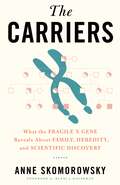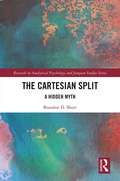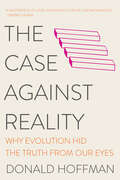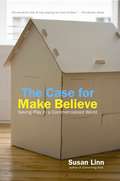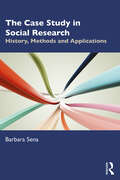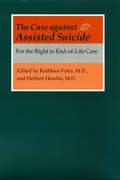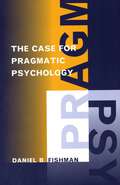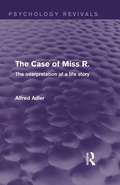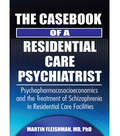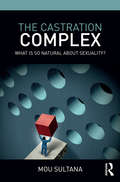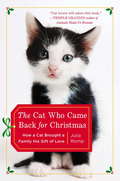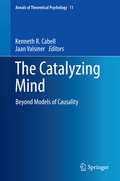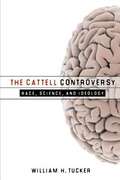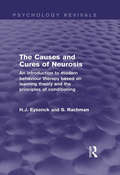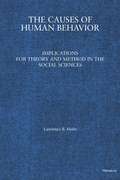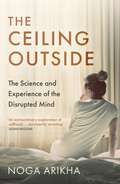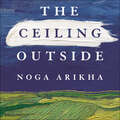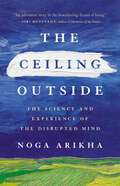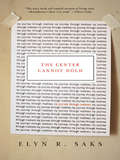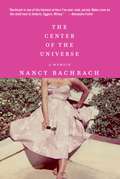- Table View
- List View
The Career Within You: How to Find the Perfect Job for Your Personality
by Elizabeth Wagele Ingrid StabbFind the Perfect Career Just for You! The Career Within You Includes: A Quiz to Determine Your Personality's "Career Type" Worksheets That Fit a Selection of Jobs to Your Strengths, Needs, and Objectives Extensive Tables of the Careers That Currently Offer the Most Money, the Most Opportunities, and the Greatest Flexibility Sample Résumés That Will Catch an Employer's Attention Detailed Tips on Preparing for a Successful Interview Success Stories of People Just Like You
The Carer’s Guide to Schizophrenia: A Concise, Problem-Solving Resource for Family and Friends
by Terence McCann Dan Lubman Gayelene BoardmanThis book will equip carers, family members and friends with the skills to support a person with schizophrenia or other psychoses. Concise language and practical problem-solving exercises throughout make this an ideal resource to easily digest and dip in and out of as needed. It begins by describing the condition in detail, going on to cover the types of treatment available, how to deal with problems and common challenges, and promoting the person's wellbeing, as well as lots of information on carer wellbeing and available help from support services.When caring for someone with schizophrenia or other psychoses, it's important to be highly knowledgeable about the person's mental health condition, how it affects them and how to help in different situations. This positive book will assist carers in every aspect of this challenging, rewarding process.
The Caricature of Love: A Discussion of Social, Psychiatric, and Literary Manifestations of Pathologic Sexuality
by Dr Hervey M. CleckleyOriginally published in 1957, this book by renowned American psychiatrist Hervey M. Cleckley focuses on two chief themes: sexual disorder and its influences, and a critical examination of some concepts of sexuality which are prominent today in psychiatry and psychology.
The Carl Rogers Reader
by Carl R. Rogers Valerie L. Henderson Howard KirschenbaumDuring his last year of life, the distinguished American psychologist Carl R. Rogers had begun work on a one-volume collection of his writings with the assistance of Howard Kirschenbaum, author of On Becoming Carl Rogers, and Valerie Land Henderson, his associate of many years. After Dr. Rogers's death in February of 1987, they completed the project. This volume stands as a splendid introduction to the life and work of a pioneering psychotherapist. Selections ranging from 1942 to 1987 provide a personal look at his early influences and marriage, and reveal his approach to psychotherapy, individual case studies, research, and even cross-cultural efforts to improve communication with professionals in the Soviet Union. We see the beginning of "client-centered" therapy and can trace Rogers's commitment to its ideals through a lifetime. In the words of Dr. Sidney B. Simon: "The Carl Rogers Reader is a gem. Between one set of covers is the glorious and essential Rogers." Book jacket.
The Carriers: What the Fragile X Gene Reveals About Family, Heredity, and Scientific Discovery
by Anne SkomorowskyA tiny mutation on the X chromosome can shape a family’s history. Passed down from a “carrier” parent to a child, fragile X syndrome is the most common inherited cause of intellectual disability and autism. Beyond that—and a rarity among genetic disorders—some fragile X carriers not only transmit the mutation but also experience related conditions themselves. In such cases, carriers can have tremors, infertility, and psychiatric disorders that complicate raising children with fragile X syndrome—and all too often, they suffer in silence.The Carriers investigates this common but still little-known genetic condition and its life-altering consequences. Anne Skomorowsky reveals how this disorder afflicts families across generations, telling the stories of the mothers and grandparents of fragile X patients and considering how genes interact with family dynamics. She interweaves the personal narratives and family histories of the people affected by fragile X disorders with clear and accessible explanations of the science behind them. Skomorowsky unpacks the latest research on the fragile X mutation and explores the history of its discovery. She highlights the roles of women as carriers, caregivers, and researchers who have made astonishing scientific breakthroughs over the last three decades.The Carriers is an essential book for fragile X families, including those just learning they are carriers, and for all readers interested in the complexities of heredity, the ethical dilemmas of genetic medicine, and the relationship between genes and personality.
The Cartesian Split: A Hidden Myth (Research in Analytical Psychology and Jungian Studies)
by Brandon D. ShortThe Cartesian Split examines the phenomenon of Cartesian influence as a psychological complex in the Jungian tradition. It explores the full legacy of Cartesian rationality in its emphasis on abstract thinking and masculinisation of thought, often perceived in a negative light, despite the developments of modernity. The book argues that the Cartesian creation of the Modern Age, as accompanied by a radical dualism, is better understood as a myth while acknowledging the psychological reality of the myth. The Cartesian myth is a collective dream, and the urgency of its rhetoric suggests that an important message is being left unheeded. This message may lead us to answers in the most unexpected place of all. The book brings forth the Cartesian myth in a new context and shows it to have potential meaning for us today. The book will be of great interest for academics, researchers, and post-graduate students in the fields of analytical psychology, mental health, comparative mythology, and Jungian studies.
The Case Against Reality: Why Evolution Hid The Truth From Our Eyes
by Donald HoffmanCan we trust our senses to tell us the truth? Challenging leading scientific theories that claim that our senses report back objective reality, cognitive scientist Donald Hoffman argues that while we should take our perceptions seriously, we should not take them literally. How can it be possible that the world we see is not objective reality? And how can our senses be useful if they are not communicating the truth? Hoffman grapples with these questions and more over the course of this eye-opening work. Ever since Homo sapiens has walked the earth, natural selection has favored perception that hides the truth and guides us toward useful action, shaping our senses to keep us alive and reproducing. We observe a speeding car and do not walk in front of it; we see mold growing on bread and do not eat it. These impressions, though, are not objective reality. Just like a file icon on a desktop screen is a useful symbol rather than a genuine representation of what a computer file looks like, the objects we see every day are merely icons, allowing us to navigate the world safely and with ease. The real-world implications for this discovery are huge. From examining why fashion designers create clothes that give the illusion of a more “attractive” body shape to studying how companies use color to elicit specific emotions in consumers, and even dismantling the very notion that spacetime is objective reality, The Case Against Reality dares us to question everything we thought we knew about the world we see.
The Case For Make Believe
by Susan LinnIn The Case for Make Believe, Harvard child psychologist Susan Linn tells the alarming story of childhood under siege in a commercialized and technology-saturated world. Although play is essential to human development and children are born with an innate capacity for make believe, Linn argues that, in modern-day America, nurturing creative play is not only countercultural-it threatens corporate profits.A book with immediate relevance for parents and educators alike, The Case for Make Believe helps readers understand how crucial child's play is-and what parents and educators can do to protect it. At the heart of the book are stories of children at home, in school, and at a therapist's office playing about real-life issues from entering kindergarten to a sibling's death, expressing feelings they can't express directly, and making meaning of an often confusing world.In an era when toys come from television and media companies sell videos as brain-builders for babies, Linn lays out the inextricable links between play, creativity, and health, showing us how and why to preserve the space for make believe that children need to lead fulfilling and meaningful lives.
The Case Study in Social Research: History, Methods and Applications
by Barbara SenaThe Case Study in Social Research proposes and develops an innovative, rigorous, and up to date methodological clarification of the case study approach in the social sciences to consistently and consciously apply it to different fields of social research. It aspires to provide the reader not with a set of prescriptive rules, but rather with a ‘methodological awareness’ of the complexity and peculiarity of applying a case study, so that they may carefully evaluate the limits and potential of conducting this type of investigation. What is case study research in the sociological field really? How do we carry out a social inquiry of this type? How does it differ from other social research approaches? In answering these questions, this book leads the reader on a historical, epistemological, technical, and applicative path in the methodology of social research, by examining all aspects of the case study approach. The aim is to respond to as-yet still equivocal and misunderstood methodological issues, and provide a systematic illustration and exemplification of the case study approach, beginning from its sociological and methodological roots, its research design, and on through to its preparation and administration. Space is also dedicated to specifically and practically understanding the differences between the case study and the other social research approaches, with which it is often confused in literature, such as ethnographic research, grounded theory, or qualitative research. This book is suitable for upper level undergraduate and postgraduate students in the social sciences, and as a supplementary textbook to primary methods texts, as well as for social researchers, and other practitioners and academics with a firm grounding in social research methodologies.
The Case against Assisted Suicide: For the Right to End-of-Life Care
by Kathleen Foley, Herbert HendinIn The Case against Assisted Suicide: For the Right to End-of-Life Care, Dr. Kathleen Foley and Dr. Herbert Hendin uncover why pleas for patient autonomy and compassion, often used in favor of legalizing euthanasia, do not advance or protect the rights of terminally ill patients. Incisive essays by authorities in the fields of medicine, law, and bioethics draw on studies done in the Netherlands, Oregon, and Australia by the editors and contributors that show the dangers that legalization of assisted suicide would pose to the most vulnerable patients. Thoughtful and persuasive, this book urges the medical profession to improve palliative care and develop a more humane response to the complex issues facing those who are terminally ill.
The Case for Pragmatic Psychology (Early American Places)
by Daniel FishmanThe best method is the one that works: &“Should be read not only by professional psychologists but by anyone interested in the future of mind-related science.&” —John Horgan, author of The End of Science A cursory survey of the field of psychology reveals raging debate among psychologists about the methods, goals, and significance of the discipline—psychology&’s own version of the science wars. The previous unification of the discipline has given way to a proliferation of competing approaches, a postmodern carnival of theories and methods that calls into question the positivist psychological tradition. Bridging the gap between the traditional and the novel, Daniel B. Fishman proposes an invigorated, hybrid model for the practice of psychology–a radical, pragmatic reinvention of psychology based on databases of rigorous, solution-focused case studies. In The Case for Pragmatic Psychology, Fishman demonstrates how pragmatism returns psychology to a focus on contextualized knowledge about particular individuals, groups, organizations, and communities in specific situations, sensitive to the complexities and ambiguities of the real world. Fishman fleshes out his theory by applying pragmatic psychology to two contemporary psychosocial dilemmas —the controversies surrounding the &“psychotherapy crisis&” generated by the growth of managed care, and the heated culture wars over educational reform. Moving with ease from the theoretical to the nuts and bolts of actual psychological intervention programs, Fishman proffers a strong argument for a new kind of psychology with far-reaching implications for enhancing human services and restructuring public policy.
The Case of Miss R.: The Interpretation of a Life Story (Psychology Revivals)
by Alfred AdlerOriginally published in 1929 the individual psychological interpretation of this autobiography was first presented by Alfred Adler to a group of psychiatrists and pedagogues in Vienna. The story of the development of a neurosis is told in this book. A young girl relates the fascinating story of her unhappy life, the psychologist comments on her remarks and leads the reader to an understanding of the blunders and mistakes which have made her life so full of suffering. Publication of this book in its day was intended to bring the growing interest in Adler’s Individual Psychology to a wider audience. Today it can be read and enjoyed in its historical context.
The Casebook of a Residential Care Psychiatrist: Psychopharmacosocioeconomics and the Treatment of Schizophrenia in Residential Care Facilities
by Martin FleishmanDiscover an alternative realm of psychiatry-without offices or couches! The Casebook of a Residential Care Psychiatrist: Psychopharmacosocioeconomics and the Treatment of Schizophrenia in Residential Care Facilities addresses the problems involved in the onsite treatment of mentally ill patients in residential care facilities. This book is the first to identify the need for psychiatrists to be available to individuals in such facilities as adult homes, community care homes, transitional living facilities, and rest homes. This vital resource also contains specific recommendations as to how these visits should be conducted with regard to frequency, duration, space, and the types of Medicare procedure codes to utilize. In The Casebook of a Residential Care Psychiatrist, Dr. Fleishman uses his 40 years of experience as a psychiatrist to show you the ins and outs of practicing psychiatry in residential facilities. The book also discusses the profound changes psychiatric drugs have produced in the social, economic, and legal arenas. Using anecdotes, personal stories, and actual documents from Dr. Fleishman&’s files, this book provides you with a wealth of knowledge not found anywhere else. With this book, you&’ll learn more about: time-saving interview/assessment techniques the importance of psychopharmacology in residential care and how it has changed the practice of psychiatry Dr. Fleishman&’s method for appropriately creating and using progress notes and other records during treatment ways to work with other members of the residential facility professional community-including psychologists, social workers, pharmacists, and administrators-to make everyone&’s job easier the best ways to control paperwork obligations the impact that federal, state, and local government agencies have had on mental health spending, services, and practitioners In The Casebook of a Residential Care Psychiatrist, you will find wisdom, knowledge, and advice along with case studies, tables and examples. While focused on psychiatry and schizophrenia, this book will be of interest to mental health workers, long-term caregivers, and residential facility administrators as well as psychiatrists and psychologists.
The Castration Complex: What is So Natural About Sexuality?
by Mou SultanaThis book illustrates that the Castration Complex and the question of the distinction between the sexes are enmeshed in psychoanalytic theories. The subjective negotiation of this distinction impacts the future sexual positions taken up (or not) by the subject, indicating that human sexuality is by no means a given or a natural occurrence in psychoanalysis. Engagement with the psychoanalytic theory of castration provides the reader with a different perspective on the current society’s insistence on gradually dissolving the differences between the sexes. For Freud, castration complex is the key to understanding the psychical consequences of the anatomical distinction between the sexes. For Lacan, castration introduces the subject to his/her very existence as a sexed being. Mou Sultana illustrates how these two revolutionary theorists came to such conclusions by close reading of the core texts, interpreting them and highlighting their relevance both within and outside the clinic of modern times.
The Cat Who Came Back for Christmas: How a Cat Brought a Family the Gift of Love
by Julia RompThe heart-warming true story of a little boy and the cat that changed his life. Julia’s nine-year-old son George was autistic. Quiet and withdrawn, he appeared lost in his own world. Then one day a small black-and-white stray cat appeared in her garden and George’s face lit up. George bonded with Ben and began to open up to his mother as well. For three happy years, the trio was inseparable and George made remarkable progress. But then disaster struck-Ben went missing and George regressed. The weeks turned into months, and Christmas was fast approaching, but on December 21, Julia got a call from a family more than fifty miles away, which finally offered a ray of hope . . . Genuinely touching, The Cat Who Came Back for Christmas is a story about devotion, love, and a holiday miracle, and is perfect for fans of Lil Bub, I Am Pusheen the Cat, and A Street Cat Named Bob. .
The Catalyzing Mind
by Jaan Valsiner Kenneth R. CabellHow do we understand and explain phenomena in psychology? What does the concept of "causality" mean when we discuss higher psychological functions and behavior? Is it possible to generate "laws" in a psychological and behavioral science--laws that go beyond statistical regularities, frequencies, and probabilities? An international group of authors compare and contrast the use of a causal model in psychology with a newer model--the catalytic model. The Catalyzing Mind: Beyond Models of Causality proposes an approach to the qualitative nature of psychological phenomena that focuses on the psychological significance and meaning of conditions, contexts, and situations as well as their sign-mediating processes. Contributors develop, apply, and criticize the notion of a catalyzing mind in hopes of achieving conceptual clarity and rigor. Disciplines such as philosophy, psychology, semiotics and biosemiotics are used for an interdisciplinary approach to the book. Research topics such as history and national identity, immigration, and transitions to adulthood are all brought into a dialogue with the concept of the catalyzing mind. With a variety of disciplines, theoretical concepts, and research topics this book is a collective effort at an approach to move beyond models of causality for explaining and understanding psychological phenomena.
The Cattell Controversy: Race, Science, and Ideology
by William H. TuckerRaymond Cattell, the father of personality trait measurement, was one of the most influential psychologists in the twentieth century, with a professional career that spanned almost seventy years. In August 1997, the American Psychological Association announced that Cattell had been selected the recipient of the American Psychological Foundation Gold Medal Award for Life Achievement in Psychological Science. Then, only two days before the scheduled ceremony, the APF abruptly postponed the presentation of the award due to concerns involving Cattell's views on racial segregation and eugenics. In addition to his mainstream research, in his publications Cattell had also posited evolutionary progress as the ultimate goal of human existence and argued that scientific criteria should be used to distinguish "successful" from "failing" racial groups so that the latter might be gradually "phased out" by non-violent methods such as regulation of birth control. The Cattell Controversy discusses the controversy that arose within the field in response to the award's postponement, after which Cattell withdrew his name from consideration for the award but insisted that his position had been distorted by taking statements out of context. Reflecting on these events, William H. Tucker concludes with a discussion of the complex question of whether and how a scientist's ideological views should ever be a relevant factor in determining the value of his or her contributions to the field.
The Causes and Cures of Neurosis: An introduction to modern behaviour therapy based on learning theory and the principles of conditioning (Psychology Revivals)
by S. Rachman H.J. EysenckOriginally published in 1965 this book was an introduction to post-Freudian methods of diagnosing and treating neurotics of the time. These methods were known collectively as ‘behaviour therapy’, a term indicating their derivation from modern behaviourism, learning theory, and conditioning principles. In the early twentieth century John B. Watson pointed out that ‘psychology, as the behaviourist views it, is a purely objective experimental branch of natural science. Its theoretical goal is the prediction and control of behaviour.’ Behaviour therapy attempts to extend this control to the field of neurotic disorders, and in doing so it makes use of experimental laboratory findings, and of theories based on these. It was seen as the very opposite of the position taken by psychoanalysis. The authors believed that, by the late twentieth century, behaviour therapy would be ‘firmly established as one of the most important, if not the most important, weapon in the hands of psychiatrists and clinical psychologists’.
The Causes of Human Behavior: Implications for Theory and Method in the Social Sciences
by Lawrence B. MohrAcknowledging that though the disciplines are supposed to be cumulative, there is little in the way of accumulated, general theory, this work opens a dialogue about the appropriate means and ends of social research based in analysis of fundamental issues. This book examines two root issues in the methodology of explanatory social research--the meaning of the idea of causation in social science and the question of the physiological mechanism that generates intentional behavior. Conclusions on these as well as on several derived problems emerge through the analysis. Among the latter, the analysis shows that neither universal nor probabilistic laws governing human behavior are possible, even within the positivist or empiricist traditions in which laws are a central feature. Instead, the analysis reveals a more modest view of what an explanatory social theory can be and do. In this view, the kind of theory that can be produced is basically the same in form and content across quantitative and qualitative research approaches, and similarly across different disciplines. The two streams of analysis are combined with resulting implications for large-sample, small-sample, and case study research design as well as for laws and theory. Written for the practicing empirical researcher in political science and organization theory, whether quantitative or qualitative, the major issuesand findings are meant to hold identically, however, for history, sociology, and other social science disciplines. Lawrence B. Mohr is Professor of Political Science and Public Policy, University of Michigan.
The Caveman Within Us: HIS PECULIARITIES AND POWERS: HOW WE CAN ENLIST HIS AID FOR HEALTH (International Library Of Psychology Ser.)
by Fielding, William JFirst Published in 1999. Routledge is an imprint of Taylor & Francis, an informa company.
The Ceiling Outside: The Science and Experience of the Disrupted Mind
by Noga ArikhaAs her mother slips into the fog of dementia, a philosopher grapples with the unbreakable links between our bodies and our sense of self. Vanessa wakes from a coma having forgotten ten years of her life. Toussaint, is haunted by voices. Thomas no longer knows how to answer questions and Claire, a retired teacher loses the use of her right hand because of an inexplicable pain. Noga Arikha began studying these patients and their confounding symptoms in order to explore how our physical experiences inform our identities. Soon after she began her work, the question took on unexpected urgency, as Arikha's own mother began to show signs of Alzheimer's disease. Weaving together stories of her subjects' troubles and her mother's decline, Arikha searches for some meaning in the science she has set out to study. She explores how the self studies itself and how it loses itself, delving into the scientific research that can help us understand how deeply interconnected are our minds and bodies. The result is an unforgettable journey across the ever-shifting boundaries between ourselves and each other.
The Ceiling Outside: The Science and Experience of the Disrupted Mind
by Noga ArikhaAs her mother slips into the fog of dementia, a philosopher grapples with the unbreakable links between our bodies and our sense of self. Vanessa wakes from a coma to find she has lost ten years of memories and that she has become a person she does not recognise. Toussaint, a Haitian immigrant, is haunted by voices. Thomas no longer knows how to answer questions and a retired teacher loses the use of her right hand because of an inexplicable pain. Noga Arikha began studying these patients and their confounding symptoms in order to explore how our physical experiences inform our identities. Soon after she began her work, the question took on unexpected urgency, as Arikha's own mother began to show signs of Alzheimer's disease. Weaving together stories of her subjects' troubles and her mother's decline, Arikha searches for some meaning in the science she has set out to study. She explores how the self studies itself and how it loses itself, delving into the scientific research that can help us understand how deeply interconnected are our minds and bodies. The result is an unforgettable journey across the ever-shifting boundaries between ourselves and each other.(P) 2022 Hodder & Stoughton Limited
The Ceiling Outside: The Science and Experience of the Disrupted Mind
by Noga ArikhaAs her mother slips into the fog of dementia, a philosopher grapples with the unbreakable links between our bodies and our sense of self. A diabetic woman awakens from a coma having forgotten the last ten years of her life. A Haitian immigrant has nightmares that begin bleeding into his waking hours. A retired teacher loses the use of her right hand due to pain of no known origin. Noga Arikha began studying these patients and their confounding symptoms in order to explore how our physical experiences inform our identities. Soon after she initiated her work, the question took on unexpected urgency, as Arikha&’s own mother began to show signs of Alzheimer&’s disease. Weaving together stories of her subjects&’ troubles and her mother&’s decline, Arikha searches for some meaning in the science she has set out to study. The result is an unforgettable journey across the ever-shifting boundaries between ourselves and each other.
The Center Cannot Hold: My Journey Through Madness
by Elyn R. SaksElyn Saks is a success by any measure: she's an endowed professor at the prestigious University of Southern California Gould School of Law. She has managed to achieve this in spite of being diagnosed as schizophrenic and given a "grave" prognosis--and suffering the effects of her illness throughout her life.Saks was only eight, and living an otherwise idyllic childhood in sunny 1960s Miami, when her first symptoms appeared in the form of obsessions and night terrors. But it was not until she reached Oxford University as a Marshall Scholar that her first full-blown episode, complete with voices in her head and terrifying suicidal fantasies, forced her into a psychiatric hospital.Saks would later attend Yale Law School where one night, during her first term, she had a breakdown that left her singing on the roof of the law school library at midnight. She was taken to the emergency room, force-fed antipsychotic medication, and tied hand-and-foot to the cold metal of a hospital bed. She spent the next five months in a psychiatric ward.So began Saks's long war with her own internal demons and the equally powerful forces of stigma. Today she is a chaired professor of law who researches and writes about the rights of the mentally ill. She is married to a wonderful man.In The Center Cannot Hold, Elyn Saks discusses frankly and movingly the paranoia, the inability to tell imaginary fears from real ones, and the voices in her head insisting she do terrible things, as well as the many obstacles she overcame to become the woman she is today. It is destined to become a classic in the genre.
The Center of the Universe: A Memoir
by Nancy BachrachThe story is so improbable, it can only be true: A brilliant woman with a long history of mental illness—who once proclaimed herself to be "the center of the universe" — is miraculously cured by accidental carbon monoxide poisoning aboard the family boat. Nancy Bachrach warns readers, “Don’t try this at home” in her darkly humorous memoir about “the second coming” of her mother — the indomitable Lola, whose buried family secrets had been driving her crazy. Aching and tender, unflinching and wry, The Center of the Universe is a multigenerational mother-daughter story—a splendid, funny, lyrical memoir about family, truth, and the resilience of love.From the Trade Paperback edition.
